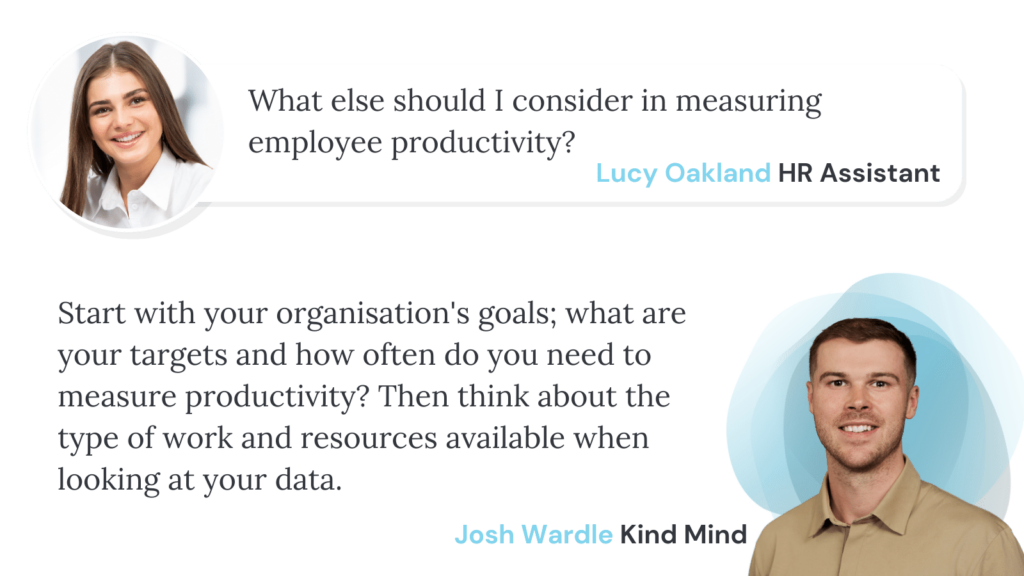We set goals for our business growth at the beginning of each year. In doing so, we predetermine what our staff need to produce to hit those goals. But how do we measure employee productivity effectively to move towards the goal line?
In this Kind Mind guide, we will take you through everything you need to know about creating productivity benchmarks to help you and your staff achieve more.
What is employee productivity?
Employee productivity measures the amount of work an employee can produce within a given period and the tools or resources used. Within that same equation, the efficiency and effectiveness of those duties are also measured to understand how employees perform tasks as individuals, by department, product or other key data points.
In other words, productivity is usually measured by the quantity and quality of work produced and the time and resources used to complete the job.
Some standard productivity measures include:
- the number of units produced
- the number of customers served
- or the revenue generated per employee.
Various factors influence employee productivity beyond what is provided to complete their task. These include; the work environment, management practices, employee motivation and engagement, plus their skills and knowledge. Understanding your employee experience at this point is critical.
Let’s talk more about why you need to measure employee productivity.

Why measure employee productivity at all?
Measuring your employee productivity is essential for several reasons.
- Identifying strengths and weaknesses – Measuring productivity helps identify areas where employees excel and may need additional support or training. This information can be used to create development plans that help employees improve their skills and achieve their full potential.
- Improving efficiency – Measuring productivity helps identify inefficiencies and bottlenecks in work processes. This information can be used to streamline your processes, eliminate waste, and improve overall efficiency.
- Setting goals and expectations – Measuring productivity helps set realistic employee expectations. This provides a clear understanding of what is expected of them and can help motivate employees to work towards achieving your goals.
- Evaluating performance – Measuring productivity provides a way to assess employee performance objectively. This information can be used to provide feedback and support, reward high-performing employees, and address performance issues.
- Making informed decisions – Measuring productivity provides valuable data that can be used to make informed decisions about resource allocation, staffing levels, and business strategy. This helps ensure that your organisation is using its resources effectively and efficiently.
- Monitoring progress – Measuring productivity allows you to monitor progress towards your goals and adjust your strategies as needed. This helps ensure that your organisation is on track to achieve its objectives.
So how do you measure productivity?
How to measure your employee productivity
Measuring employee productivity can be done in various ways, depending on the work’s nature and the organisation’s goals.
Here are some standard methods for measurement:
- Quantity of output measures an employee’s work over a given period. For example, a sales representative may be evaluated based on the number of sales they make in a month.
- Quality of output measures the quality of work an employee produces. For example, a graphic designer may be evaluated based on the quality of their designs, or a customer service representative may be evaluated based on customer satisfaction scores.
- Time-based productivity measures an employee’s time on a particular task or project. For example, a software developer may be evaluated based on the number of lines of code they write in a day.
- Cost-based productivity measures the cost of producing a particular output or delivering a particular service. For example, a manufacturing plant may be evaluated based on the cost per unit of production.
- Targeted Key performance indicators (KPIs) are specific, measurable goals established to help employees and managers focus on the most critical aspects of their job. For example, a marketing manager may be evaluated based on the number of leads generated or the conversion rate from leads to sales.
To measure employee productivity effectively, it is vital to establish clear performance metrics and provide regular feedback and support to employees. It is also essential to consider factors affecting productivity, such as work environment, workload, and employee morale.
By measuring employee productivity, organisations can identify areas for improvement, set goals and expectations, and optimise their workforce to achieve their business objectives.
Is there a single formula for measuring employee productivity?
There is no single formula for calculating employee performance, as performance metrics can vary depending on the nature of the work being performed and your organisation’s goals. However, using the points of measure above, you can quickly establish realistic benchmarks for your staff based on the job, department and even product or service.
Common employee productivity KPIs
Here are some key performance indicators (KPIs) related to employee productivity that organisations commonly use to measure performance:
- Revenue per employee – This measures the amount of revenue generated per employee and helps you understand the efficiency of your workforce. To calculate revenue per employee, divide the total revenue generated by the number of employees.
- Sales conversion rate -This measures the percentage of sales opportunities that result in a sale. To calculate the sales conversion rate, divide the number of sales by the number of sales opportunities and multiply by 100. A high sales conversion rate indicates that employees effectively close deals and generate revenue.
- Customer satisfaction – This measures how satisfied customers are with the products or services provided by the organisation. A high customer satisfaction score can indicate that employees are performing well and providing high-quality service. Customer satisfaction can be measured through surveys, reviews, or other feedback mechanisms.
- Employee engagement – This measures how engaged and committed employees are to their work and your organisation. Employee engagement can be measured through surveys, focus groups, or other feedback mechanisms. Higher levels of employee engagement have been linked to higher productivity levels.
- Time to complete tasks – This measures how long it takes employees to complete tasks or projects. A shorter time to completion can indicate higher levels of productivity. Time to complete tasks can be measured through project management tools or time-tracking software.
- Error rates – This measures the number of errors or mistakes employees make while performing their work. A lower error rate indicates that employees perform their work accurately and efficiently. Error rates can be measured through quality control processes or other feedback mechanisms.
- Presenteeism – This measures the period of time when employees come to work while sick and are less productive. High presenteeism is when employees come to work very sick and cannot perform their duties or interact with staff. Mid-presenteeism is when employees come to work while not feeling well and are able to perform their duties but not at their best. Low presenteeism is when employees come to work while feeling slightly under the weather but can still perform their duties at a high level. Self-reported surveys, supervisor ratings, and error rates can help measure it.
It’s important to note that these KPIs are just examples and may not apply to all industries or job functions. Choosing metrics relevant to the work’s specific context and your organisation’s goals is important when selecting your KPIs.
How often should you measure employee productivity?
The frequency of measuring employee productivity depends on several factors, including the nature of the work being performed, the goals of your organisation, and the resources available for measuring productivity.

Here are some factors to consider when determining how often to measure your employee productivity:
- Type of work – The frequency of measuring productivity may vary depending on the work performed. For example, it may be more appropriate to measure productivity daily for tasks requiring high repetition and speed, such as data entry or call centre work. In contrast, it may be more relevant to measure productivity every month for tasks that require longer-term planning and execution, such as project management or software development.
- Goals of the organisation – The frequency of measuring productivity may also depend on the organisation’s goals. Suppose the organisation has specific targets or milestones that need to be met. In that case, it may be necessary to measure productivity more frequently to ensure that progress is being made towards those goals.
- Resources available – If the organisation has limited resources for measuring productivity, measuring performance less frequently may be more practical.
In general, it is recommended to measure employee productivity regularly, whether daily, weekly, monthly, or quarterly. This allows for timely feedback and adjustments to improve productivity and achieve organisational goals. However, it is also essential to balance measuring productivity and allowing employees the autonomy and flexibility to do their work without feeling constantly monitored or micromanaged.
Good employee productivity benchmarks
There is no one-size-fits-all benchmark for employee productivity, as productivity levels vary widely depending on the industry, company size, and job function. However, there are several methods for establishing benchmarks that will help you get started.
Industry standards
One way to establish a benchmark for employee productivity is to look at industry standards and compare your organisation’s productivity levels to those of other companies in the same industry.
Historical data
Another way to establish a benchmark for employee productivity is to look at historical data within your organisation. This can help identify trends and patterns in productivity levels over time.
Internal goal-based benchmarks and KPIs
Setting internal productivity benchmarks can help identify improvement areas and track progress towards achieving organisational goals. For example, a team may set a benchmark for completing a certain number of tasks within a specified time frame.
Establishing KPIs specific to your organisation and job functions can help establish more detailed benchmarks for productivity. These KPIs should be based on the goals and objectives of your organisation and should be measurable and achievable.
It’s essential to remember that all of your productivity benchmarks should be realistic and achievable, considering your organisation’s specific context. It’s also important to regularly review and adjust benchmarks to ensure they remain relevant and valuable.
How to start improving your employee productivity
Improving employee productivity can significantly benefit both the employee and the employer by increasing job satisfaction, career advancement opportunities, and compensation. This means employers see improved efficiency, higher revenue, and greater profitability.
Here are some steps to help you improve your employee productivity:
- Set clear goals and expectations – Employees need to know what is expected of them regarding their roles and responsibilities and what goals they need to achieve. Clear goals and expectations can help employees focus their efforts and prioritise their work.
- Provide the necessary resources – Employees need access to the resources they need to perform their work effectively, such as equipment, tools, and training. Providing these resources can help employees work more efficiently
- Foster a positive work environment – A positive environment that promotes collaboration, communication, and respect can help employees feel motivated and engaged. This can lead to higher levels of productivity.
- Encourage regular breaks – Encouraging employees to take frequent breaks can help prevent burnout and improve focus and concentration. Breaks can also provide an opportunity for employees to recharge and refocus.
- Offer employee wellness provision – Simply put, happy staff perform better. Their wellness and well-being have a lot to do with that. That’s why we created a wellness program based on the employee experience.
- Offer incentives – Offering incentives, such as bonuses or promotions, can motivate employees to work harder and improve their productivity. Incentives can also show employees that their hard work is recognised and valued.
- Implement performance metrics – Tracking employee productivity through performance metrics can help identify areas where employees may need additional support or training. This can help improve employee performance over time.
- Provide feedback and coaching – Regular feedback and coaching can help employees identify areas for improvement and develop their skills. This can lead to higher levels of productivity and job satisfaction.
Overall, improving employee productivity requires a holistic approach that considers the needs of the employees, the organisation, and the work being performed. By creating a supportive work environment and providing the necessary resources and incentives, you can help employees work more efficiently and effectively.
Good luck.
Are you looking for more guides on HR benchmarks? Read our latest articles here.






